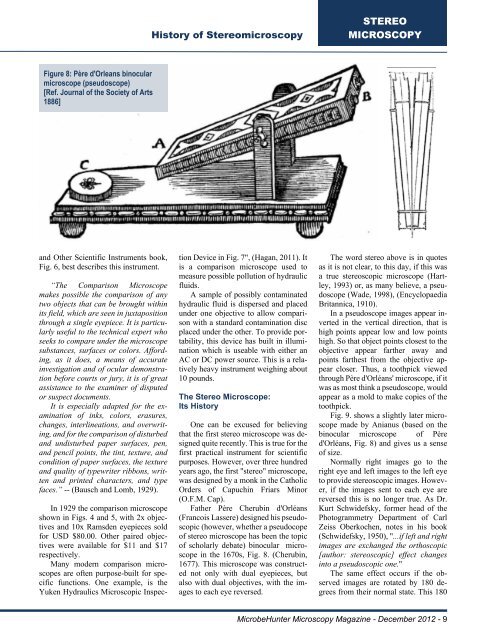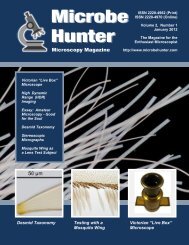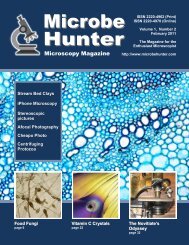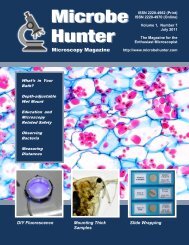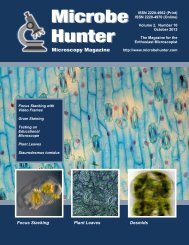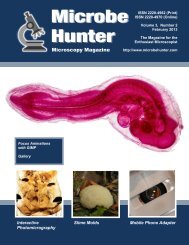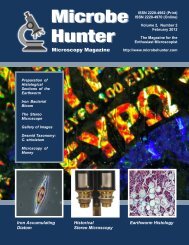December 2012 - MicrobeHunter.com
December 2012 - MicrobeHunter.com
December 2012 - MicrobeHunter.com
You also want an ePaper? Increase the reach of your titles
YUMPU automatically turns print PDFs into web optimized ePapers that Google loves.
History of StereomicroscopySTEREOMICROSCOPYFigure 8: Père d'Orleans binocularmicroscope (pseudoscope)[Ref. Journal of the Society of Arts1886]and Other Scientific Instruments book,Fig. 6, best describes this instrument.“The Comparison Microscopemakes possible the <strong>com</strong>parison of anytwo objects that can be brought withinits field, which are seen in juxtapositionthrough a single eyepiece. It is particularlyuseful to the technical expert whoseeks to <strong>com</strong>pare under the microscopesubstances, surfaces or colors. Affording,as it does, a means of accurateinvestigation and of ocular demonstrationbefore courts or jury, it is of greatassistance to the examiner of disputedor suspect documents.It is especially adapted for the examinationof inks, colors, erasures,changes, interlineations, and overwriting,and for the <strong>com</strong>parison of disturbedand undisturbed paper surfaces, pen,and pencil points, the tint, texture, andcondition of paper surfaces, the textureand quality of typewriter ribbons, writtenand printed characters, and typefaces.” -- (Bausch and Lomb, 1929).In 1929 the <strong>com</strong>parison microscopeshown in Figs. 4 and 5, with 2x objectivesand 10x Ramsden eyepieces soldfor USD $80.00. Other paired objectiveswere available for $11 and $17respectively.Many modern <strong>com</strong>parison microscopesare often purpose-built for specificfunctions. One example, is theYuken Hydraulics Microscopic InspectionDevice in Fig. 7", (Hagan, 2011). Itis a <strong>com</strong>parison microscope used tomeasure possible pollution of hydraulicfluids.A sample of possibly contaminatedhydraulic fluid is dispersed and placedunder one objective to allow <strong>com</strong>parisonwith a standard contamination discplaced under the other. To provide portability,this device has built in illuminationwhich is useable with either anAC or DC power source. This is a relativelyheavy instrument weighing about10 pounds.The Stereo Microscope:Its HistoryOne can be excused for believingthat the first stereo microscope was designedquite recently. This is true for thefirst practical instrument for scientificpurposes. However, over three hundredyears ago, the first "stereo" microscope,was designed by a monk in the CatholicOrders of Capuchin Friars Minor(O.F.M. Cap).Father Père Cherubin d'Orléans(Francois Lassere) designed his pseudoscopic(however, whether a pseudocopeof stereo microscope has been the topicof scholarly debate) binocular microscopein the 1670s, Fig. 8. (Cherubin,1677). This microscope was constructednot only with dual eyepieces, butalso with dual objectives, with the imagesto each eye reversed.The word stereo above is in quotesas it is not clear, to this day, if this wasa true stereoscopic microscope (Hartley,1993) or, as many believe, a pseudoscope(Wade, 1998), (EncyclopaediaBritannica, 1910).In a pseudoscope images appear invertedin the vertical direction, that ishigh points appear low and low pointshigh. So that object points closest to theobjective appear farther away andpoints farthest from the objective appearcloser. Thus, a toothpick viewedthrough Père d'Orléans' microscope, if itwas as most think a pseudoscope, wouldappear as a mold to make copies of thetoothpick.Fig. 9. shows a slightly later microscopemade by Anianus (based on thebinocular microscope of Pèred'Orléans, Fig. 8) and gives us a senseof size.Normally right images go to theright eye and left images to the left eyeto provide stereoscopic images. However,if the images sent to each eye arereversed this is no longer true. As Dr.Kurt Schwidefsky, former head of thePhotogrammetry Department of CarlZeiss Oberkochen, notes in his book(Schwidefsky, 1950), "...if left and rightimages are exchanged the orthoscopic[author: stereoscopic] effect changesinto a pseudoscopic one."The same effect occurs if the observedimages are rotated by 180 degreesfrom their normal state. This 180<strong>MicrobeHunter</strong> Microscopy Magazine - <strong>December</strong> <strong>2012</strong> - 9


